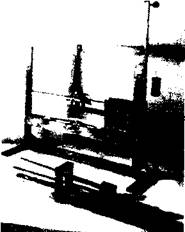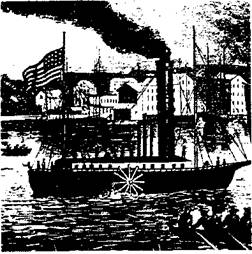home
 Economy Economy
 books books
 The history of the world economy - Polyak GB The history of the world economy - Polyak GB
|
The history of the world economy - Polyak GB
23.3. The industrial revolution in the US
Background redposylki the industrial revolution of the XIX century. in the economic history of the world - this is the era of the formation of industrial civilization. In this century it ends with the industrial revolution, which covers all of the country - and Europe, and America.
The historical and economic conditions of the US industrial revolution preconditions were as follows.
First of all, here the political preconditions have been prepared as a result of the war of independence the country has achieved independence and could provide at the freedom of business and commerce. The country has developed a specialization areas and deepen the territorial division of labor, so that the farm drawn into commodity-money circulation and agriculture gained commercial character, stimulating industrial development especially the Northeast.
It played a role a lack of labor market. In the colonies was not created "surplus" population. At the first opportunity salaried workers, even of immigrants who want to own land and left the business. This determined the high cost of labor, invention and stimulated the import of machinery and equipment from England.
Technical background of the industrial revolution in the United States were prepared success in England, where he had started earlier: In the United States introduced a system to encourage inventions. Since 1790 he acted patent law, according to which the inventor was given a 14 years monopoly on the use of his invention. Subsequently, the validity of such rights have been increased. Naturally, this contributed to the development of technical thought.
The sources of funds for the development of large-scale industrial production of steel: the profit of the commercial bourgeoisie, revenues from foreign trade, farm incomes, income from speculative land deals.
It promotes industrial revolution economic policy of the state, which was reflected in the reorientation of the beginning of XIX century. Investment from the sphere of trade and navigation in the industry, as well as the establishment of a protective tariff. According to customs tariffs in 1816 on imported fabrics were set high import duties, and then to rise in the coming years. It protected the US production from foreign competition.
Features of the industrial revolution
Joining the machine later stage in England, the United States used English technical expertise, thus making its own and a significant contribution. This allowed a synthesis path of the United States to carry out the industrial revolution in a relatively short period of 40-50 years.
We single out the main features of the industrial revolution in the United States.
1. An important feature of the industrial revolution in the United States was the active role of the US engineering: invented the sewing machine, rotary printing machine, phosphoric match, electromagnetic telegraph Morse, direct-printing unit D. Hughes, a revolver, a pneumatic brake. All these innovations are born in the United States, we determined the development of many new industries. Singer Sewing Factory, Becker, Wheeler produced products that were in demand all over the world. And indeed the Singer sewing machine was known and popular even in Siberia.

Telegraph by Samuel Morse
2. The essential features of the industrial revolution in the United States were predetermined by natural conditions of the country. Thus, due to the abundance of rivers the country was rich in water power, cheaper than steam power. So here later began to be used on a mass scale steam power. The transition to steam power base (system) started only in the 40s of XIX century., Although the first steam engine appeared in the late XVIII century. and in 1803 it was invented the steam engine of Oliver Evans.
"The machine and steam - that's the formula technological revolution in England. The machine and the water wheel - that's the formula for the first phase of the machine stage of American capitalism "- as determined by a specialist features and stages of the industrial revolution in the United States *. The steam engine has taken a dominant position only in the 50s of XIX century.
* Op. on the History of the world economy. Book One. - M., 1997.- 164 pp.
3. Another feature of the industrial revolution linked to the abundance of forests in the country, which explains the long-term use as a principal form of charcoal fuel. Up until 1860 the United States consumed the wood railways. The first blast furnace, coal-fired, appeared in this country only in 1837. The delay in the replacement of wood fuel is also due to the fact that iron, smelted it, getting the best quality. The massive use of fossil fuel in the steel industry began in the 40-ies., When for the 1847-1857 biennium. built here 100 domain running on coal.
4. As the US later started the industrial revolution, the manufactory capitalism in full is not formed. Manufacture, arose in the colonial period were not sustainable; their development is constrained restrictive policy of England. Therefore correct to speak about the fact that the industrial revolution took place in conditions of underdevelopment manufacturing.
5. A feature of the industrial revolution in the United States was and extreme territorial and sectoral unevenness. First of all, he seized the north-eastern states; at the same time in the south even to the beginning of the Civil War was not factories, which could not but have an impact on its outcome. It is dominated by primary processing of crops - cotton, tobacco, rice, sugar cane, etc. In addition, if here and used the machine, they are served by slaves...
Delayed on the time frame of formation of industrial capitalism and the western states, although the former zone of colonization, but had even small workshops, equipped with a steam engine. And the use of the experience drawn from a north-eastern states and England, led to the absence of the manufacturing stage or reduce its duration. Sectoral structure of the emerging industry are different from the North-East. Western states have specialized in food processing, wood materials, the production of agricultural machinery.
Destinations of the industrial revolution
The industrial revolution began in the North-East of the country. The first branch, which was to move to machine production was cotton. Invented in 1793 by E. Whitney's cotton gin made it possible to convert the cotton processing and to provide raw cotton production. Various improvements have turned it into a high-performance machine that increases productivity by 100 times. But this machine was served by slaves. English immigrant textile workers C. Slater memory was drawing vaternoy machine used in England. Later Slater has become a major employer, and it is called the "father" of American industry. For the first time in world practice, spinning and weaving machines have been installed at the cotton mill, built by Lao udlom in 1814. Since then, the raw material processing and production of finished products have been linked to a single production cycle. In 1832, the US has worked 795 cotton mills (625 of them in the north-eastern states), they are used by 1.2 million spindles.; were printed cottons machines and other technical innovations.
Gradually introduced machines and more sophisticated wool production. Already in 1840 in the Northeast home wool production gave way to machine.
Northeast US was the center of the textile industry, where 78% of the factories of this industry was concentrated. Since the 40s began consolidation of textile factories. The mechanization of the textile industry has reduced its unit costs, to lower the price of fabric for the 1815-1850 biennium. five times, a reduction in the import from England.
In light industry, the industrial revolution in addition to textile covered food (mainly milling), footwear, garment, leather. The invention of the sewing machine Singer in 1841, as well as machines for the manufacture of footwear in 1846 significantly increased the productivity and quality of products, and stimulated the development of sub-sectors of mechanical engineering.
Another important direction of the industrial revolution in the United States - the development of transport. Previously, all the transformation affected the construction of canals - it began in the late XVIII century. In the first quarter of XIX century. for connecting the Great Lakes with the Atlantic Ocean we have built the biggest longest Erie Canal, which is much cheaper to transport. During this construction project was followed by the construction of canals in other states. By the middle of the XIX century. length of artificial waterways has reached 6 thousand. km. an extensive system of canals was created. Building them was carried out with the help of the state, whose share in total assets was 75% (3/4).
Development of navigation contributed to the invention in 1807 Robert Fulton world's first paddle steamer "Clermont", launched on to the river. Hudson. In 1814 Fulton built the first military wheeled steam ship "Demalogos". Go to the 40s to the screw steamers led to a decisive shift in the naval business. The quality of American courts are not inferior to the English. The tonnage of the United States and the courts of England in the middle of the XIX century. almost caught up. In 1838, the American ship "Sirius" and "Great Western" crossed the Atlantic Ocean.

The world's first paddle steamer "Clermont"
The first rails joined Baltimore and Ohio (1828-1830), for the next two decades, the length of railways has increased 300 times. No country in the world does not know this rate of construction of the railway. The huge area of the state has been linked together by means of messages that operate year-round. The Government assisted the railway construction.
The revolution in transport has caused the accelerated development of metallurgy, mining and forest industry, mechanical engineering. Therefore we can assume that the 40-ies of the second phase of the industrial re gates t Metallurgy in the United States developed slowly and only in the 40s are widely used puddling furnace in the United States. The first blast furnace using coal, was built in 1837. Extraction of coal at the height of the industrial revolution has increased 20 times. For the 1830-1850 biennium. pig iron production increased by three times. Relsoprokatnoe business began to develop from 1845, but the metal is not enough, and most of the rails was imported from England. Centers were metallurgy Pittsburgh; new centers were established in the West (Tennessee, Kentucky), in Pennsylvania, Ohio.
In the middle of the XIX century. the US already had major engineering plants, for example, in New York for the production of steam engines, Pennsylvania, etc. This meant the introduction of the industrial revolution in the final stage -. creation of machines production of machinery (mechanical engineering). In 1818, E. Whitney invented the milling machine Gang cutting tool (cutter). Whitney laid the foundations of technology and mass production in mechanical engineering.
The US became a major producer of locomotives, ships and agricultural machinery. American locomotives were used on European railways. In 1851 the locomotive was created in the United States. In the 60s built sleeping cars, tank wagons glaciers.
If in the first half of the XIX century. for the construction of railway bridges used wooden truss and rail fastening (system Gau), with the 40-ies began to build bridges with iron through-farms of different systems. Building bridges with long spans and heavy loads require accurate and reliable calculations. In the US shipbuilding yards housed foreign orders. Since the 40s the iron begins to be used for covering the courts and then built hull.
Agricultural Engineering Products US and shipped abroad. The main factor raising the industry was progression-free farming. In the 40-50-ies appeared seeders, threshers, mowers and other machines. The most important was the invention of a combined reaper and thresher with the winnower. There are other models of agricultural machines. By 1851 it has been patented at least 167 harvesting machines and 62 mowers.
As a result, the US industrial revolution began industrial country - 67.3% of its industrial production provided the Northeast. However, the US has not at all able to meet its internal needs and resorted to the importation of European (English) products. Foreign trade of the United States is booming in the first half of the XIX century. it has increased by about four times, but in the export of finished products accounted for only 13%. During this period, against the protectionist policies of the planters of the South fought in need of imported manufactured goods. The pace of development of the industry were very high: from 1827 to 1860. US industrial output volume increased by eight times.
Banks. Cash system
There were changes in the US monetary system. After the War of Independence old British scale of prices was replaced and put a decimal monetary system, the public greeted unkindly. The transition to the new system was implemented just after the Civil War, when introduced bimetallic standard.
If in the era of colonization of the credit operations were a function of private associations, to make loans, usually on security of land and to issue paper money, during the formation of the industry was already in the formation of the capitalist credit system.

Trehdollarovay bill
To ensure the army during the War of Independence, Congress introduced a revolutionary taxes. The US government issued debt obligations due to lack of hard currency. A feature of the banking system was the participation in the monetary circulation and crediting of individual states. However, the decentralization of currency issue (issuing business) led to the disruption of the economy. It took a decision on the state level. Bank of the United States was granted in 1791 the right to conduct banking operations and especially the regulation of money circulation in order to protect the economy from inflation. Since the legislative control over the banking activities has been established. This right was set at 20 years of age and when the term expired in 1811, the bank served the entire country, creating corresponding offices in all major port cities.


Comments
Commenting, keep in mind that the content and the tone of your messages can hurt the feelings of real people, show respect and tolerance to his interlocutors, even if you do not share their opinion, your behavior in terms of freedom of speech and anonymity offered by the Internet, is changing not only virtual, but real world. All comments are hidden from the index, spam control.